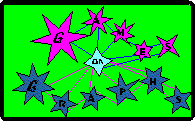 Materials
Materials
 that all students can see, such as one that is drawn on the floor with masking tape, or
a copy for each student or group of students.
that all students can see, such as one that is drawn on the floor with masking tape, or
a copy for each student or group of students.
A famous mathematician, Paul Erdos, has offered a large cash prize for the person who succeeds in drawing the graph that solves this problem. They could win it.
Eventually after much trial and error someone may come up with a graph that meets the criteria. Or perhaps after enough experimentation with various possibilities, someone will be able to explain why it is that size 12 is the largest that such a graph can be. If time and perseverance are what is needed to solve this problem, there is no reason why the person to solve it cannot be a child.
These are the largest known graphs with the minimum degree and maximum diameter as indicated. It has been proved that the graph above with the maximum degree of 4 is the largest one that can be drawn with diameter 4, but it is not known if it is possible to draw a larger graph than the one shown that has maximum degree 3 and diameter 4.
In general it is not known what the largest possible graphs that have relatively small degree and relatively large diameter are. Experiment with some graphs of your own and send in the graphs that you draw and what you have learned about them. Because this mathematical territory has not been studied very much, you may be the one to make a discovery that could find its way into a mathematical journal.




